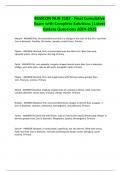BSMCON NUR 2102 - Final Cumulative
Exam with Complete Solutions |Latest
Update Questions 2024-2025
Macule - ANSWER Flat, circumscribed area that is a change in the color of the skin. Less than
1cm in diameter. Freckles, flat moles, measles, scarlet fever. Primary
Papule - ANSWER Elevated, firm, circumscribed area less than 1cm. Wart (verruca),
elevated moles, cherry angioma, skin tag. Primary
Patch - ANSWER Flat, non palpable, irregular-shaped macule more than 1cm in diameter.
Vitiligo, port wine stain, cafe-au-alit spots, mongolian spots. Primary
Plaque - ANSWER Elevated, firm, and rough lesion with flat top surface greater than
1cm. Psoriasis, eczema. Primary
Wheal - ANSWER Elevated, irregular-shaped area of cutaneous edema; solid, transient;
variable diameter. Insect bites, urticaria, allergic reaction. Primary
Nodule - ANSWER Elevated, firm, circumscribed lesion, deeper in dermis than a papule. 1-
2cm in diameter. Lipomas, melanoma, hemangioma, neurofibroma. Primary
Tumor - ANSWER Elevated and solid lesion; may or may not be clearly demarcated; deeper in
dermis; greater than 2cm in diameter. Neoplasms, lipoma, hemangioma. Primary
Vesicle - ANSWER Elevated, circumscribed, superficial, not into dermis, filled with serous
fluid; less than 1cm in diameter. Varicella (chickenpox), herpes zoster (shingles), acute
eczema. Primary
,Bulla - ANSWER Vesicle greater than 1cm in diameter. Blister, lupus. Primary
Pustule - ANSWER Elevated, superficial lesion; similar to a vesicle but filled with purulent
fluid. Impetigo, acne, folliculitis, herpes simplex. Primary
Cyst - ANSWER Elevated, circumscribed, encapsulated lesion; in dermis or subcutaneous
layer; filled with liquid or semisolid material. Sebaceous cyst or cystic acne. Primary
Scale - ANSWER Heaped-up keratinized cells; flaky skin; irregular; thick or thin; dry or oily;
variation in size. Flaking of skin with seborrheic dermatitis following scarlet fever or following
a drug reaction. Eczema. Secondary
Lichenification - ANSWER Rough, thickened epidermis secondary to persistent rubbing,
itching, or skin irritation; often involves flexor surface of extremity. Chronic dermatitis,
psoriasis. Secondary
Keloid - ANSWER Irregular-shaped, elevated, progressively enlarging scar; grows beyond
the boundaries of the wound. Formation could occur following surgery. Secondary
Scar - ANSWER Thin-to-thick fibrous tissue that replaces normal skin following injury or
laceration to the dermis. Healed wound or surgical incision. Secondary
Excoriation - ANSWER Loss of the epidermis; linear hollowed-out trusted area. Abrasion or
scratch, scabies. (Picture someone having run into some briars in the woods or a cat scratch
on the arm)
Fissure - ANSWER Linear crack or break from the epidermis to the dermis; may be moist or dry.
Athlete's foot, cracks at the corner of the mouth, chapped hands, eczema.
Crust - ANSWER Dried drainage or blood; slightly elevated; variable size; colors variable - red,
black, tan or mixed. Scab on abrasion, eczema
,Erosion - ANSWER Loss of part of the epidermis; depressed, moist, glistening; follows rupture
of a vesicle or bulla (blister). Varicella, candidiasis, herpes simplex.
Ulcer - ANSWER Loss of epidermis and dermis; concave; varies in size. Pressure ulcer,
syphilis chancre
Atrophy - ANSWER Thinning of the skin surface and loss of skin markings; skin
appears translucent and paper like. Aged skin, striae, discoid lupus erythematosus
What do you need to note when inspecting lesions? - ANSWER -Color
-Elevation: flat, raised, or pedunculated
-Pattern or shape
-Configuration
-Size: measure in cm or common household object
-Location & distribution on body
-Exudate: color &/or odor (serous, serosanguinous, sanguinous, purulent)
Vascular Skin Lesions - ANSWER Petechiae, Purpura, Ecchymosis, Angioma, Capillary
hemangioma, Telangiectasis, Vascular spider (spider angioma), Venous star
Petechiae - ANSWER Tiny, flat, reddish-purple, nonblanchable spots in the skin less than 0.5cm
in diameter; appear as tiny red spots pinpoint to pinhead in size.
Purpura - ANSWER Flat, reddish-purple, nonblanchable discoloration in the skin greater than
0.5cm in diameter
Ecchymosis (bruise) - ANSWER Reddish-purple, nonblanchable spot of variable size
, Angioma - ANSWER Benign tumor consisting of a mass of small blood vessels; can vary in size
from very small to large
Capillary Hemangioma (Nevus Flammeus) - ANSWER Type of angioma that involves the
capillaries within the skin producing an irregular macular patch that can vary from light red
to dark red to purple in color
Telangiectasia - ANSWER Permanent dilation of preexisting small blood vessels (capillaries,
arterioles, or venules) resulting in superficial, fine, irregular red lines within the skin
Vascular Spider (Spider Angioma) - ANSWER Type of telangiectasia characterized by a
small central red area with radiating spiderlike legs; this lesion blanches with pressure
Venous Star - ANSWER Type of telangiectasia characterized by a nonpalpable bluish, star-
shaped lesion that may be linear or irregularly shaped
Suspected Deep Tissue Injury - ANSWER Localized area of discolored (purple or maroon) intact
skin or blood-filled blister caused by underlying soft tissue damage resulting from pressure or
shear. May include a blister over a dark wound bed; would may become covered with eschar.
Common Shapes & Configurations of Lesions - ANSWER Annular, Confluent, Discrete, Grouped,
Gyrate, Target/Iris, Linear, Polycyclic, Zosterform
Onycholysis - ANSWER painless separation of the nail from the nail bed
Example of Documentation of Findings - ANSWER Skin warm, pink, & dry throughout. Turgor is
brisk & skin is elastic. Rough, thickened skin over heels, elbows, & knees; otherwise, skin is
smooth. A 0.5 cm yellow pustule on right shoulder & 4.5 cm scar on right knee. Multiple striae
throughout lower abdomen. Hair brown with female distribution, soft texture. Nails smooth,
rounded, & manicured.




